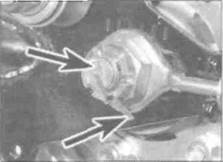
|
Читайте также: |

|
| 2.4 Plain nut (A), shouldered locknut (B), nylon insert nut (C) and castellated nut (D) |
• Conventional plain nuts are usually six-
sided (see illustration 2.4). They are sized by
thread diameter and pitch. High tensile nuts
carry a number on one end to denote their
tensile strength.

|
| 2.5 Bend split pin (cotter pin) arms as shown (arrows) to secure a castellated nut |

|
• Self-locking nuts either have a nylon insert, or two spring metal tabs, or a shoulder which is staked into a groove in the shaft -their advantage over conventional plain nuts is a resistance to loosening due to vibration. The nylon insert type can be used a number of times, but must be renewed when the friction of the nylon insert is reduced, ie when the nut spins freely on the shaft. The spring tab type can be reused unless the tabs are damaged. The shouldered type must be renewed every time it is disturbed.
• Split pins (cotter pins) are used to lock a castellated nut to a shaft or to prevent slackening of a plain nut. Common applications are wheel axles and brake torque arms. Because the split pin arms are deformed to lock around the nut a new split pin must always be used on installation - always fit the correct size split pin which will fit snugly in the shaft hole. Make sure the split pin arms are correctly located around the nut (see illustrations 2.5 and 2.6).
Bend split pin (cotter pin) arms as shown to secure a plain nut
Caution: If the castellated nut slots do not align with the shaft hole after tightening to the torque setting, tighten the nut until the next slot aligns with the hole - never slacken the nut to align its slot.
• R-pins (shaped Ike the letter R), or slip pins as they are sometimes called, are sprung and can be reused if they are otherwise in good condition. Always install R-pins with their closed end facing forwards (see illustration 2.7).
ref.6 Tools and Workshop Tips
 2.7 Correct fitting of R-pin. Arrow indicates forward direction
2.7 Correct fitting of R-pin. Arrow indicates forward direction
Дата добавления: 2015-10-29; просмотров: 170 | Нарушение авторских прав
| <== предыдущая страница | | | следующая страница ==> |
| Dust, eye and hand protection | | | Thread repair |